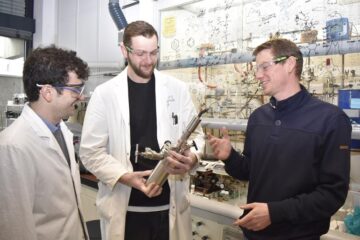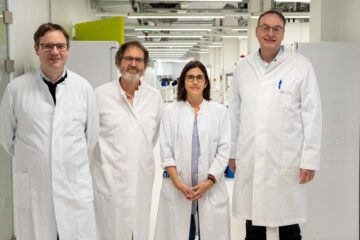Clemson researchers collect and reuse enzymes while maintaining bioactivity

Enzymes are round proteins produced by living organisms that increase the rate of chemical reactions.
“We found a robust and simple way of attracting specific enzymes, concentrating them and reusing them,” said Stephen Foulger, professor in the School of Materials Science and Engineering at Clemson. “The enzymes are still functional after being harvested.”
Isolating a single type of protein from a complex mixture is the most difficult aspect of the purification process. It is vital to determine the function, structure and interactions of the protein.
The researchers baited a nanoparticle to capture and recycle an enzyme. They found a way to attach an enzyme’s target on the surface of a particle, allow the enzyme to bind to it, remove the particle and determine that the enzyme is still functional.
“We took a protein that was being produced in a soil and placed its food source on the outside of a nanoparticle and the protein essentially grabbed onto the food source,” said Foulger. “We froze the enzyme in place and removed the particle and thus found a commercially viable way to harvest these proteins.”
“This baited particle approach provides a very efficient means for isolating complex enzyme systems for use in biotechnology,” said Vincent Rotello, a chemistry professor at the University of Massachusetts Amherst and leading researcher in the field. “This method also provides considerable promise for biomedical applications.”
The research established a universal model for concentrating and extracting known enzyme pairings, but it can be an invaluable tool in recognizing unknown ones.
“This model is foreshadowing for what we’re doing with cancer research because we’re beginning to focus on the 'outside' of nanoparticles to sequester specific proteins that direct cancer cell growth,” said Foulger.
The researchers’ goal is to alter the cellular concentration of critical proteins in cancer to disrupt the cell's ability to spread, thereby controlling its growth in the body.
Media Contact
More Information:
http://www.clemson.eduAll latest news from the category: Life Sciences and Chemistry
Articles and reports from the Life Sciences and chemistry area deal with applied and basic research into modern biology, chemistry and human medicine.
Valuable information can be found on a range of life sciences fields including bacteriology, biochemistry, bionics, bioinformatics, biophysics, biotechnology, genetics, geobotany, human biology, marine biology, microbiology, molecular biology, cellular biology, zoology, bioinorganic chemistry, microchemistry and environmental chemistry.
Newest articles

Efficient, sustainable and cost-effective hybrid energy storage system for modern power grids
EU project HyFlow: Over three years of research, the consortium of the EU project HyFlow has successfully developed a highly efficient, sustainable, and cost-effective hybrid energy storage system (HESS) that…

Safer alternative for an explosive reaction
The chemical industry has been using a reaction with explosive chemicals for over 100 years – now Mülheim scientists have discovered a safer alternative. The Ritter Group of the Max…

How immune cells communicate to fight viruses
Chemokines are signalling proteins that orchestrate the interaction of immune cells against pathogens and tumours. To understand this complex network, various techniques have been developed to identify chemokine-producing cells. However,…





















